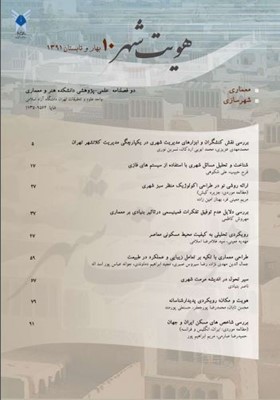رویکردی تحلیلی به کیفیت محیط مسکونی معاصر
محورهای موضوعی : معماریمهدیه معینی 1 , غلامرضا اسلامی 2
1 - دانشکده هنر و معماری ، دانشگاه آزاد اسلامی واحد کرمان، ایران
2 - دانشیار دانشکده ی معماری پردیس هنرهای زیبا، دانشگاه تهران، تهران، ایران.
کلید واژه: residential environment quality, کیفیت, Quality, کیفیت محیط مسکونی, رویکرد کیفیت_ محور, کیفیت محیط انسان ساخت, quality-based approach, built environment quality,
چکیده مقاله :
بستر اجتماعى - اقتصادى ایران معاصر زمینه ساز توسعه نگرش کمیت گرا به محیط مسکونى شده است. پى آمد این تفکر کاهش کیفیت محیط مسکونى بوده است. بنابراین این پژوهش، به منظور ارائه راه حل هایى براى کیفیت بخشى به محیط مسکونى بر اساس بازشناسى مفهوم کیفیت در محیط انسان ساخت و تحلیل آن با رویکردى جامع، نظریه هاى کیفیت_ محور را در قالب سامانه اى چند لایه از نظام سلسله مراتبى تدوین نموده و رابطه درونى دو مؤلفه "مشخصه هاى اساسى کالبد محیط مسکونى" و"نیازها و توقعات برگرفته از ارزش هاى فرهنگى و اجتماعى ساکنان" را در قالب سازمانى نظام مند براى برنامه ریزى و طراحى این محیط ها تبیین می کند. با استفاده از تحلیل محتوا، مفهومى از کیفیت را در حوزه معنا شناسى یافته و با استناد به استدلال منطقى، به تعیین مراتب و مؤلفه هاى کیفیت محیط انسان ساخت و تحلیل کیفیت محیط مسکونى معاصر می پردازد.
The socio-economic conditions of contemporary Iran has caused an expansion in a quantity-based attitude towards residential environments. This has resulted in the problem of decreasing quality of residential environments and increasing dissatisfaction of its residents. For this reason, through content analysis, this research tries to find a definition of quality with subjective and objective aspects in the semantics field, and in proportion to initial cognition sources. By means of referring to logical argumentation in order to present solutions for qualifying residential environments, this research attempts to use a better understanding of the concept of quality in the built environment, in order to analyze quality-based theories in general and specific theories related to architecture, in the form of linear and hierarchical multilevel systems. Moreover, this paper determines internal relationships between "basic features of residential environment" and "needs and expectations of residents' socio-cultural values" using an interaction-based comprehensive approach. This interactive relation is defined as the satisfaction level of a residential environment, which is itself derived from the balance between expectations extracted from subjective images of residents, their needs, and the range of environments that are a reaction to them. The relationship between the aforementioned features, specify the quality of residential environments in a way that more responsiveness of the environment to residents’ needs and expectations, becomes directly related to an increase in residents’ satisfaction. Therefore, effective solutions for improving the quality of residential environments becomes dependent firstly, on our basic knowledge about residents' needs and their material and spiritual expectations, and then on increasing the capabilities of the physical environment for a sustainable response to these needs and expectations. In such an approach, the residential environment, in terms of formal cause-effect, will have special and basic characteristics related to factors creating it. We therefore cannot achieve qualified environments through repeating a uniform physical pattern for all residential environments. On the other hand, capabilities of such environment in fulfilling the needs and expectations of residents, which are extracted from their values in terms of ultimate cause-effect, leads to interactive projects and appropriate evaluations of residential environments. If this evaluation is done by both the residents and the designers, at the level of subjective cause-effect, the result of such dynamic process, from theory to case and vice versa, will be harmonious with environmental adaptation for responding to residents' needs and expectations, thus leading to improving the quality of sustainable residential environments. In the future, in order to create residential environments that possess a sustainable quality, there must be a movement toward a deeper look at housing, and encouragement of projects that are based on a close relationship between residents and designers; builders and programmers. Otherwise, programming to build residential environments will be solely based on economic exploitation of building developers. The result of this approach is repeating similar patterns for unequal beneficiaries, and providing for needs and expectations that are extracted from general socio-cultural patterns. The development of such an imbalanced relationship will cause more resident dissatisfaction and lower quality of residential environments, which will in turn lead to socio-cultural abnormalities and poorer quality of life.
Calif: Sage Publication.
[On line] http:// www,mazur,net/works/Zultner_Mazur_2006_Kano_Recent_Developments, pdf.
New York.
_||_


